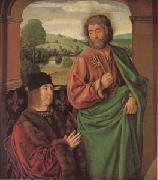Wholesale Oil Painting No Minimum |
|||||||||||
|
|
|||||||||||

|
|||||||||||
|
|
|
||||||||
Jean HeyFlemish Northern Renaissance Painter, active 1480-1500 Until the late 20th century, the name of the painter of the Moulins Triptych was unknown, although art historians identified a number of other works that were evidently by the same hand. The first monograph on the Master of Moulins, written in 1961 by Madeleine Huillet d'Istria, argued that this artist did not actually exist, and that more than 12 different artists were responsible for the corpus of works traditionally ascribed to him. The Master's identity was established after an inscription was found on the reverse of a damaged painting, Christ with Crown of Thorns (1494) in the Royal Museums of Fine Arts of Belgium, Brussels, identifying the artist as Jean Hey, teutonicus and pictor egregius ("the famous painter"), and identifying the patron as Jean Cueillette, who was secretary to the King and an associate of the Bourbon family.Stylistic similarities link this painting to the works attributed to the Master of Moulins. The Master of Moulins appears to have been the court painter for the Bourbons, and from a surviving account for 1502-03, it is clear that the court painter's name was Jean; other candidates once considered plausible, such as Jean Perreal and Jean Prevost, have proven untenable in the light of subsequent research. The term "Teutonicus", or "German" included Flemings at this date. |
||||||||
|
|
||||||||
Pierre II Duke of Bourbon Presented by St Peter (mk05)
Pierre II Duke of Bourbon Presented by St Peter (mk05) Painting ID:: 20016 |
ca 1492-1493
Wood 28 1/2 x 25 1/2\'\'(73 x 65 cm)Entered the Louvre in 1842 ca 1492-1493 Wood 28 1/2 x 25 1/2\'\'(73 x 65 cm)Entered the Louvre in 1842 |
|||||||
|
CONTACT US |

